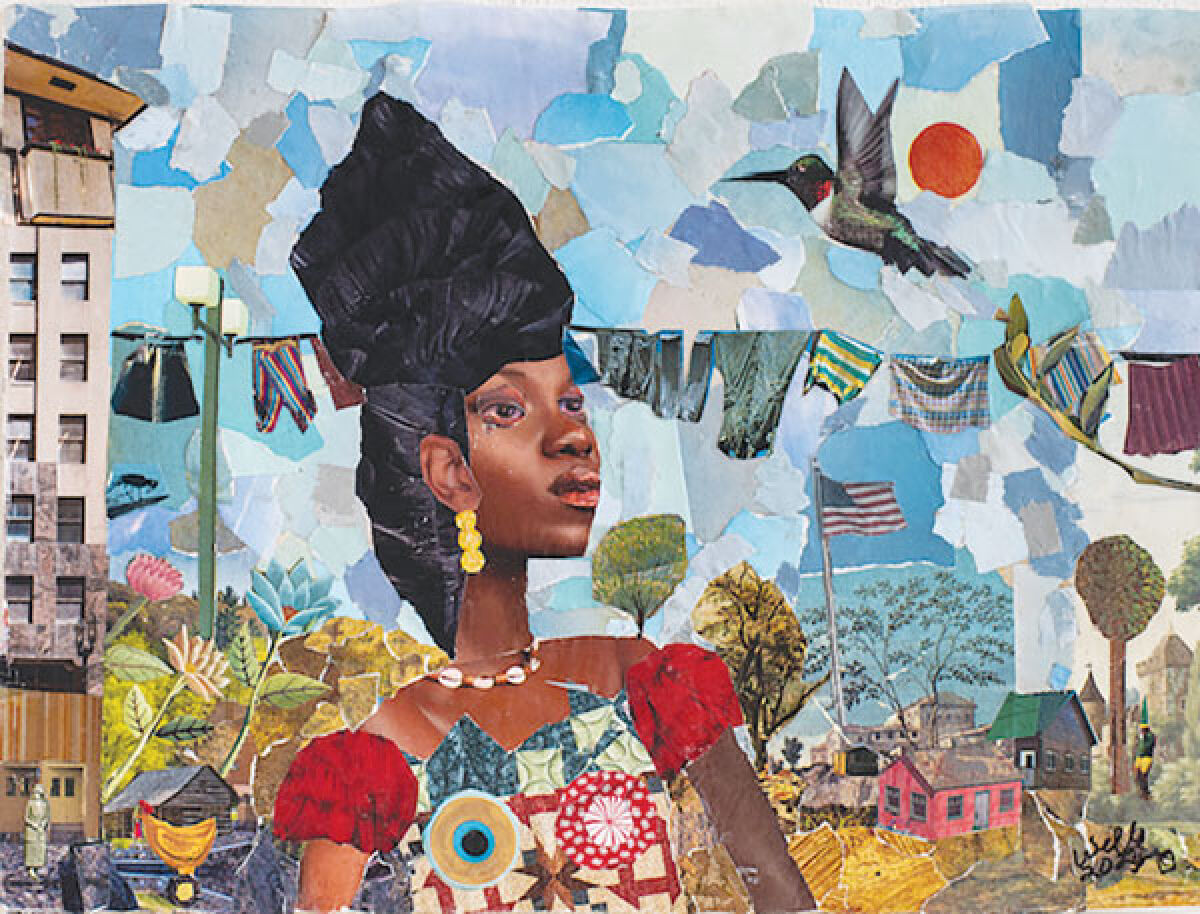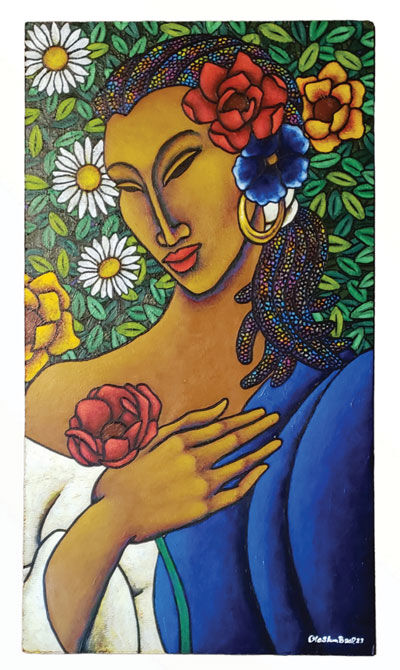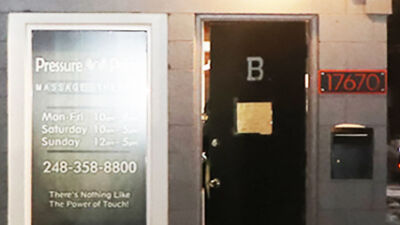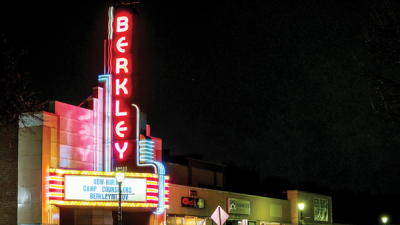SOUTHFIELD — Umoja is the Swahili word for “unity,” a meaning that Umoja Fine Arts’ owner and curator Ian Grant said he is committed to upholding. The Grant family opened Umoja in 1996 with the ambition of “displaying American life in a positive form, and preserving and recording the historical accounts in graphic form.”
For the third year in a row, Umoja, in partnership with Fashion International and Tanji Grant, is presenting the “Blooming in Color” exhibit, featuring internationally acclaimed artists Della Wells and LaShun Beal, as well as local emerging artists Alga Washington and Lamarr Sanders.
The “Blooming in Color” exhibit will be open to the public from April 28 to June 30. An opening reception will be held 5-9 p.m. Friday, April 28, and 1-6 p.m. Saturday, April 29. People can register for the opening reception for an opportunity to meet the artists in the showcase. At Saturday’s reception, LaShun Beal will deliver a speech on his process of creating art and his experience as an artist, followed by a Q&A session.
Detroit native and Houston-based LaShun Beal is making his return back to the Motor City after being gone for over 25 years. Beal has traveled throughout Europe, South America and Southeast Asia in the name of art.
“Throughout my travels, I found many cultures hold women in reverence, and I try to depict that adoration for femininity in my pieces,” he said. Using various mediums, Beal experiments with color and tone to depict his “Universal Woman,” a racially ambiguous woman inspired by the beauty Beal has seen in women all around the world.
Beal knew he was an artist from very early on. “I started producing (art) in elementary school and then started selling in fifth grade. I haven’t looked back since then. I had a lot of support from teachers, staff and parents. Those were my first clients.”
Beal recognizes that the world of art is always changing, and as an artist, he said he is in tune with the wants and needs of the consumer without sacrificing his authenticity as an artist.
“My work has evolved leaps and bounds over time. And the thing about being in this industry and doing it for commercial purposes is that you’re constantly trying to figure out the pulse of what people may want. So, you have to be able to experiment with different things and see what clicks.” Beal explains that though his main medium is acrylic paint on canvas, he also sculpts, works with wood, builds furniture and does “anything that pertains to art.”
For Beal, there’s no external motivation, per se. He said that the mere act of creating helps to inspire him from within. Now that he’s in his 60s, he said that he views things differently than he did when he was a younger artist, and he is now reaching his “third or fourth generation of consumers,” which impacts the type of art he produces. As a mentor to young artists, Beal emphasizes the importance of finding your voice as an artist and learning how to articulate that voice, while at the same time understanding the business aspect of producing art. Beal advises up-and-coming young artists to seek advice and mentorship from seasoned artists.
“As a young artist, the best thing you can do is find an established artist to mentor you,” he said. “When you’re first starting out, you’re naïve, and finding someone who has been doing this for a long time can tell you some of the things you can avoid. There are directions you may want to consider going into that you may not have thought about yet. They can advance your career by leaps and bounds just by learning from their experiences.” Beal encourages any aspiring artists wanting to learn more about this field to contact him.
The Milwaukee-based Della Wells started out later in life as an artist. Wells explained that her interest in art was always in other people’s work, and she didn’t start seriously making art until she was 42 and had gone back to school to be a psychologist after getting injured on her job.
“I always knew how to draw, but to be honest with you, if you told me when I was younger that I would be an artist, I would’ve laughed at you,” Wells stated.
She explained that for her, being an artist was something that had never occurred to her. She always believed that to be an artist, you had to have something to say. While she was back in the classroom taking a required humanities course in art survey, she found herself wanting to write her academic papers on local Milwaukee African American artists, so she contacted Evelyn Patricia Terry. Wells had actually met Terry a few times throughout the years at a gallery, so when the two reunited, Terry recalled Wells’ drawings of Picasso-like women and babies and told her that she was an artist. Wells laughed, “I was thinking she was out of her mind.” Terry tried to convince Wells for two years to make art. It wasn’t until Terry invited Wells to a show at a gallery that she heard a voice telling her it was time to make art.
“A voice told me to go make art, and so I told her (Terry) I was ready,” Wells said. “I thought it was the spirits of the ancestors telling me to go make art, so I did. Two weeks later, I went to her studio, and on the first day, I made three pieces: two pastels and a monoprint. It was really relaxing for me because, at the time, I was in a lot of pain physically and emotionally from being injured on the job.” Terry told Wells that she’d give her a show if she completed 50 pieces of art. Wells actually did two shows on her own before reaching 50 pieces.
Little did Wells know that she would become a critically acclaimed artist whose work would be exhibited internationally. In 2012, a play depicting Wells’ life was written for a performance at the Kennedy Center in Washington, D.C., and in 2016, she was awarded the city of Milwaukee’s Artist of the Year award. Wells’ artwork is currently on backorder, so when she was asked to be in Umoja’s show, she created some pieces for the exhibit. One of the pieces featured in the exhibit, “Looking Forward to a New Day,” is inspired by Wells’ 7-year-old twin granddaughters looking toward the future.
Around 1995, Wells began to do collage work, and she continues to work with things that most people would discard.
“I reference old material culture because we’re such a throwaway culture today. I must say it really started with my generation, because, in my mother’s time, they saved everything when they were growing up. We are such a disposable culture now. When I look at stuff, I look at the possibilities, and I feel like that’s just like human beings too. We kind of throw away human beings. I know my mother felt thrown away. Other people have felt thrown away. I’ve felt thrown away. But if you look at the pieces, it’s how you put the pieces of your life together is what’s important.”
During the creation process, Wells draws back to characters she created in her childhood to escape from the struggles she faced growing up with a mother who battled mental illness and a father with anger issues. Her collage art features beautiful Black women called “mambos” who are “high priestesses of themselves who aren’t going to let anyone tell them they aren’t beautiful. They don’t give up their power, because they are always going to be powerful, and their mission is to empower other people.”
Grant explained that the art industry is experiencing an uptick in African American artists, and the demand isn’t exclusive to the African American consumer.
“My favorite thing in the last five years is that African American art is the fastest-growing segment in the entire art world because we’ve been undervalued and underappreciated,” Grant stated. “It’s our turn.
“This is one of our strongest shows, and it’s very exciting, because it’s filled with positive images with flowing, beautiful colors. It’s a free event open to the public and families. It’s all about them seeing the beauty of the art, educating them about art, our legacy that we are preserving through the arts.”
To register for Umoja’s “Blooming in Color” opening reception, visit https://umoja finearts.com/.
 Publication select ▼
Publication select ▼


























